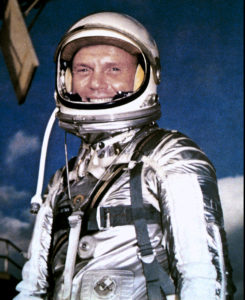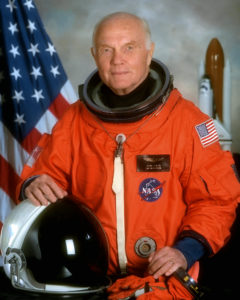Dec
11
Godspeed, John Glenn
“Zero G, and I feel fine.” — Col. John Glenn
On December 8, 2016, America and the world lost a hero and, some might even say, a “living legend”, when former Marine aviator, astronaut, and U.S. Senator John Glenn passed away at the age of 95. He will be laid to rest at Arlington National Cemetery.
Glenn enlisted in the U.S. Navy as an aviation cadet in March 1942 but was later transferred to the Marine Corps. According to Wikipedia, “From June 1944, stationed in the Marshall Islands, he flew 59 combat missions until his return, bombing and strafing Japanese positions in the area. He was hit by antiaircraft fire five times, and was awarded two Distinguished Flying Crosses and ten Air Medals.” After WWII he flew missions with a Corsair squadron in China and Guam. In the early 1950s, Captain Glenn spent time as a flight instructor before being posted to the staff of the Commandant, Marine Corps Schools.
In October 1952, the now-Major Glenn was assigned to a fighter squadron in South Korea, with whom he flew 63 combat missions. He later participated in an interservice exchange with the U.S. Air Force, where he was able to fly 27 combat missions in an F-86 Sabre with the 25th Fighter-Interceptor Squadron. For his service in the Korean War, Glenn was awarded 8 Air Medals and 2 Distinguished Flying Crosses.
Glenn attended the U.S. Naval Test Pilot School in 1954. “From November 1956 until April 1959, Glenn was assigned to the Fighter Design Branch of the Navy Bureau of Aeronautics in Washington, D.C., during which time he also attended the University of Maryland.” He was awarded a fifth DFC for completing the first supersonic transcontinental flight in July 1957 and was promoted to lieutenant colonel in April 1959.
Once he was selected for Project Mercury in 1959, Glenn was assigned to the NASA Space Task Group, Langley Research Center, Hampton, Virginia. (The group moved to Houston in 1962.) I won’t go into his accomplishments in detail, but Glenn’s NASA career was quite noteworthy. As part of the Mercury Seven group, he performed research experiments, participated in scientific breakthroughs, dodged death several (more) times, and set new records. For example:
“In 1962, Glenn circled the Earth three times over the course of less than five hours, traveling faster than 27,359 km/h (17,000 mph) on board the Mercury capsule “Friendship 7” – a ship run by a computer less powerful than an iPhone.” — Sarah Marquart, Futurism.com
Glenn was the third American in space and the first to orbit the Earth. This flight boosted the national morale by showing that America still had the “right stuff” to at least match the Soviet Union, who had already put men in orbit, and possibly lead the “Space Race”. (It was the height of the Cold War, after all.)
“It seemed that he had given Americans back their self-respect and more than that — it seemed Americans dared again to hope.” — Walter A. McDougall, author, quoted by the New York Times
The “clean-cut, good-natured, well-grounded” Ohioan, Col. John Glenn, became a national hero and an iconic figure, while inspiring many others to seek careers in aerospace. He also met and became friends with President John F. Kennedy and the Kennedy family. JFK awarded Glenn the NASA Distinguished Service Medal on Feb. 23, 1962. Glenn resigned from astronautics in 1964 and went into private industry.
Glenn later entered politics and became a U.S. Senator (D-OH) in December 1974, and he represented Ohio until January 1999. While in office, he served as the Chair of the Senate Governmental Affairs Committee from 1987 to 1995. But Glenn was itching to see Earth from orbit again, so he lobbied NASA for two years to allow him to go up in a Space Shuttle “as a human guinea pig for geriatric studies.” On Oct. 29, 1998, he became the oldest person to ever go into space at age 77, when he served as a Payload Specialist on Discovery’s STS-95 mission. Glenn and the crew spent 9 days up there and orbited the planet 134 times.
What then? According to Wikipedia, “Glenn helped found the John Glenn Institute for Public Service and Public Policy at The Ohio State University in 1998 to encourage public service. On July 22, 2006, the institute merged with OSU’s School of Public Policy and Management to become the John Glenn School of Public Affairs, and Glenn held an adjunct professorship at the Glenn School. In February 2015, it was announced that the School would become the John Glenn College of Public Affairs beginning in April 2015.” Of course, he was also a member — either regular or honorary — of various boards, clubs, and societies, from the International Academy of Astronautics to the International Association of Holiday Inns (as a former franchise owner).
Not many know it, but Glenn was also a Freemason and an elder in the Presbyterian Church (PCUSA). He was noted for saying, “To look out at this kind of creation and not believe in God is to me impossible.” Based on the following quote, I’m guessing he was some manner of Theistic Evolutionist:
“I don’t see that I’m any less religious that I can appreciate the fact that science just records that we change with evolution and time, and that’s a fact. It doesn’t mean it’s less wondrous and it doesn’t mean that there can’t be some power greater than any of us that has been behind and is behind whatever is going on.”
I may not have agreed with Glenn’s positions on a number of issues both political and theological, but I certainly respect his service to America in the military, NASA, and as an earnest public servant. He made a great contribution to science and society, and he was and is an inspiring figure. Thank you for your service, sir!

















